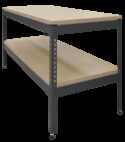Experiment
STS3

Shear Force in a Beam (Next Generation Structures)
Experiment that illustrates and proves the basic theory of shear force in a beam. Mounts on the Structures platform and connects to the Structures automatic data acquisition unit and software (VDAS® Onboard).
If you have any questions or you'd like to discuss a product, please call us.
+44 1159 722 611Shear Force in a Beam (Next Generation Structures)
One of a range of experiment modules that fit to the Structures platform (STS1, available separately), this product helps students to understand how loads affect the bending moment in a beam.
Students apply loads to hangers suspended along the beam, held between two supports. One support allows rotational movement only, acting as a pinned support. The other support allows translational movement, acting as roller support. At the mid-span of the beam a load cell inside an articulated parallelogram measures the shear force at a ‘cut’ due to the load. The beam has a central span with an overhanging end, so that students can create both positive and negative shear force.
Each support includes pointers that work with the scale on the platform for accurate positioning. Students use textbook equations to predict the shear forces at the cut due to the load, comparing them with measured results, and learn how to create the influence line and shear force diagrams. This helps confirm the reliability of the textbook equations and the accuracy of the experiment results.
This product includes a uniformly distributed load (UDL) that may be applied across the span of the beam for comparison of results with a single point load.
The load cell connects to the USB Interface Hub of the Structures Platform for computer display and data acquisition (VDAS® Onboard).
*There are 21 different experiments in the Next Generation Structures range. View them all in this easy to view flyer here.
Learning outcomes
• Shear force at the cut due to a varying single point load
• Shear force at the cut due to a moving single point load
• Shear force at the cut due to a uniformly distributed load
• Influence lines and superposition













